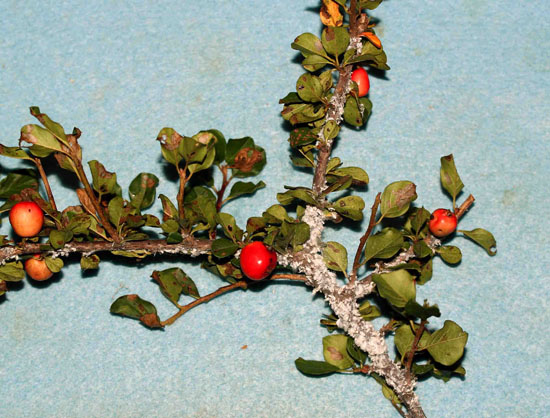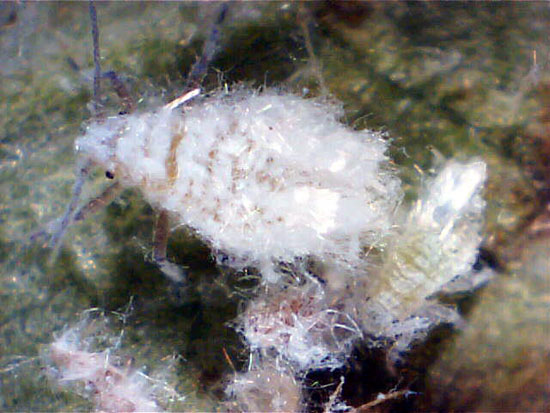Issue 15, August 28, 2009
Woolly Apple Aphid
Woolly apple aphid, Eriosoma lanigerum, is common this year on crabapple, cotoneaster, strawberry, and other rose family plants. Other rose family hosts include hawthorn, mountain ash, and pyracantha. From a distance, stem and leaf undersides appear whitish and cottony. Their presence is attracting various predators including large numbers of lady beetles, lacewings, and syrphid flies. The honeydew they produce attracts numerous cicada killers, yellowjackets, bumblebees, and other bees and wasps. Thus, a client's report of large numbers of wasps flying around a tree may be due to an infestation of woolly apple aphids.

Woolly apple aphid adults are about one-eighth inch long and covered with white, waxy filaments, making them look like tiny, oval cotton balls. Nymphs may only have filaments protruding from the posterior half of the abdomen. Unlike most aphids, they do not have obvious cornicles, paired tailpipe-like structures near the end of the abdomen. They do have the characteristic aphid-like, long antennae. Winged adults fly very slowly and appear as one-eighth inch in diameter floating balls of white fluff in late spring and early fall.

They are numerous on leaf undersides and along stems, completely covering portions of the stems. They feed by sucking out the plant sap from phloem vessels, removing the nitrogen, some of the water, and a small portion of the carbohydrates, excreting the rest out of the anus as a concentrated sap or light syrup-like liquid called honeydew.
Not only do these insects feed on the leaves and stems of rose family plants, they also feed on the roots of the same plants. They descend below ground where their feeding on plant sap can result in galls being formed by the plant. On younger trees and shrubs or on heavily-attacked plants, these galls can cause enough root damage to reduce plant health. However, host plants commonly do not produce galls in response to this feeding, resulting in less impact on the plant. In some locations, movement of the woolly apple aphids up and down the trunk from roots to stems and back again can be observed during the summer.
In the fall, woolly apple aphids produce winged individuals that fly to American elm. Mating occurs later in the fall on elm and eggs are laid on that host for the winter. However, nymphs can also spend the winter feeding on the roots of the rose family host. In the spring, the eggs hatch on elm with the aphids completing several generations feeding on elm before flying to a rose family host in late spring. Their feeding on American elm can cause curled, deformed leaves, resulting in a rosette effect. Those that overwintered on the roots of the rose family host can stay on the roots to feed while others will migrate up the tree to feed on the stems and leaves for the summer.
Although American elm is uncommon in many urban areas due to Dutch elm disease, it is still the most common tree species in Illinois forests. Because Dutch elm disease typically does not kill the tree until a few years after reaching reproductive age, American elms are continuing to be produced in nature, they just don't get very large. These trees function as overwintering hosts as well as the roots of the rose family hosts.
It does not appear that these woolly apple aphid infestations are causing much damage to their hosts. Trees and shrubs do not show any dieback or leaf loss from aphid attack. Galls can be formed on twigs and branches in response to aphid feeding, but that has not been observed in Illinois. Realize that many attacked as well as uninfested crabapples will show defoliation from apple scab, which clientele may blame on the aphids. It is more likely that you may wish to control the aphids to reduce the honeydew, its stickiness and resulting sooty mold on surfaces, and its attraction to wasps and bees.
Although their waxy filaments protect woolly apple aphid somewhat from insecticide sprays, thorough coverage should result in control of those on the leaves and stems. It is not practical to control those on the roots. You need to be sure that your client understands that reinfestation from the roots could occur. Treatment of American elm will only be needed if damage occurred in the spring on that host.
Most contact insecticides will provide control of above ground infestations of woolly apple aphid. Insecticidal soap, summer spray oil, malathion, acephate (Orthene), and labeled pyrethroids such as cyfluthrin (Tempo), bifenthrin (Onyx), and permethrin (Astro) should be effective. Systemic insecticides such as acephate (Lepitect) and imidacloprid (Merit, Imicide, Pointer, Xytect) will also provide control.--Phil Nixon
Author:
Phil Nixon